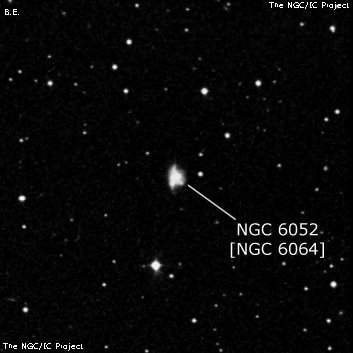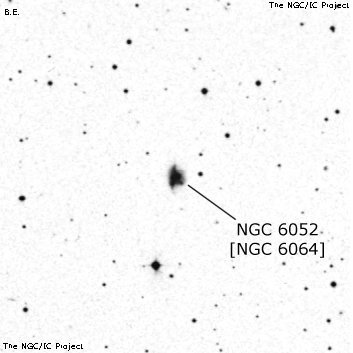NGC/IC Project Restoration Effort
(This is a very very beta version)
NGC6052


Basic Information
Location and Magnitude
Right Ascension: 16:5:13.2
Declination: +20:32:32
Constellation: HER
Visual Magnitude: 13.0
Historic Information
Discoverer: Marth
Year of discovery: 1864
Discovery aperture: 48.0
Observational
Summary description: F, pL, iR (? = III 140)
Sub-type: S/P
Corwin's Notes
=====
NGC 6052 = NGC 6064, which see.
Steve's Notes
=====
NGC 6052
48" (4/5/13): the main glow of this disrupted system or merger appeared fairly bright, fairly small, slightly elongated, irregular or mottled. The glow brightens along the eastern side and very thin, faint extensions protrude along the eastern side to the north and south (more prominent on the south end). The appearance is similar to an edge-on galaxy attached to the larger, mottled western component.
48" (5/15/12): at 488x, the disrupted system NGC 6052 = Arp 209 had a very strange appearance. Attached on the southeast side is a faint, elongated glow, ~22"x6", extending out from the main portion of the system and giving the strong impression that an edge-on galaxy was involved in this merger. Also on the northeast side, a fainter and broader extension or plume was visible oriented N-S. Although these two features seemed detached, they may be part of the same partially merged galaxy. To the west of these extended features is the most prominent region or core of the galaxy, which appeared bright, irregular round and mottled. The halo was very irregular in shape and brightness, particularly on the west side which had a mottled, tattered appearance.
24" (7/23/14): using 375x, moderately bright, fairly small, elongated 3:2 N-S, ~25"x18". Contains an extremely small nucleus that appears offset to the north side. The eastern component is merged, except for a small, thin extension that juts out to the south on the southeastern side. A mag 15 star lies 0.8' W.
24" (6/28/14): at 375x, appeared fairly faint, fairly small, elongated 3:2 N-S, 30"x20", contains a quasi-stellar nucleus and mottled core that is slightly displaced to the north side. The two components were not clearly resolved.
18" (7/12/10): fairly faint, fairly small, very elongated 3:1 N-S, 0.9'x0.3', fairly even surface brightness except at 285x and 335x there was a very faint, slightly brighter "bulge" or knot on the west side (VV 86a) in the direction of a faint star 45" W. On the SDSS, this is a highly disrupted system with jets or knots of material appearing to shoot out on the west side.
17.5": fairly faint, fairly small, oval ~N-S, bright core. Appears asymmetric as the galaxy is brighter on the west side. The POSS reveals this is an attached contact system (Arp 209). A mag 14.5 star is 1' W.
13.1" (7/5/83): faint, small, round, even surface brightness. In line with two mag 12/13 stars equally spaced.
8" (7/5/83): extremely faint, very small, at visual threshold.



